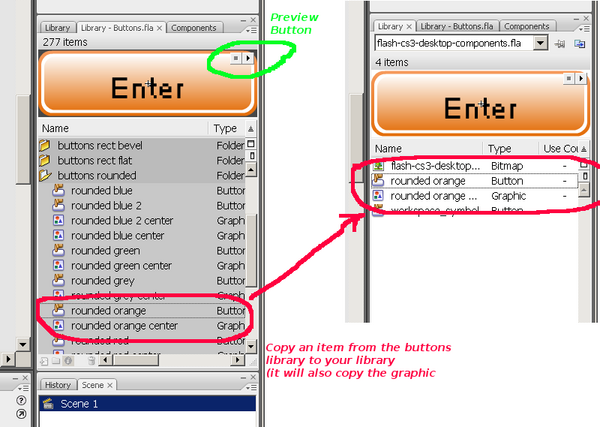Flash CS3 button tutorial
This article or section is currently under construction
In principle, someone is working on it and there should be a better version in a not so distant future.
If you want to modify this page, please discuss it with the person working on it (see the "history")
Definition
This is part of Flash CS3 tutorials.
Goals:
- Introduce buttons
- Show how to use pre-built buttons
- (Maybe: how to make your own)
Introduction
Buttons are interface components to add simple interactivity, such as displaying extra information, launch a movie clip etc.
Button symbols are some sorts of specialized movie clips.
Creating your own buttons
Using the built-in Flash button symbols
Flash contains a good variety of pre-built buttons.
To use these, your first should add the Library-Buttons.fla panel with Window->Common Libraries->Buttons (see the Flash CS3 desktop tutorial on how to add a panel).
Buttons are arranged in folders, double click to open these. Then, you may may inspect various symbols by clicking a button. In the upper part of the panel you get a preview. Click on the arrow to see how it behaves.
To use a button in your animation I suggest to copy it first to your own libary. This way you can find the button again easily and you can modify its features.
- Right-click on the Symbol and Copy
- Paste it to your own library. Open the library panel and hit crtl-V
From your library panel simply drag the button on the stage. This will create an instance of the button. To remove it from the stage, select it and hit the delete key. Make sure you operate with instances in your flash animation (not symbols themselves). If you did this right, you will see in the properties panel something like Instance of: rounded orange.
Customizing symbols and instances
To customize a button symbol, double click on the icon of the symbol library panel. This will let you work just on this object, i.e. it puts you into a Symbol editing mode. There are other ways to get into this editing "inside" (via the general menu or right-click on an instance).
Now you can for instance change the font or the color of a symbol or make changes to its frame-by-frame animations.
To find your normal workspace (scene) again select Edit->Edit Document (Ctrl-E).
- I suggest to add the Edit bar: Window->Toolbars->Edit bar. It will show you exactly at what level you are editing, e.g. scene or button.
- You also may add the Scene Panel with Window->Other Panels; Scene (or hit Shift+F2).
Now a symbol is basically something that you can use several times over, but its fundamental look and feel properties will remain the same, including for instance the label.
So if you need buttons with other labels you must create copies of these symbols. In your library panel right-click on the icon of the symbol and select duplicate from the popup menu. Choose an appriate name.
To change the label (and font) of a button, choose the select button in the tools menu and double-click a few times on a button until you get the text tool selected (cursor starts blinking and "T" is selected in the tools bar)
Hint: If you can't select a button after changing a label, double-click in the gray area (backstage).
The four frames and the button layers
Built-in button symbols contain four frames and several layers. For each frame, different drawings may be defined but some, e.g. the label text may be reused in several layers
To display frames and layers of a button, double-click on the button.
The four pre-defined frames used for buttons are:
- Up
The button, i.e. the drawing that appears "as is"
- Over
The button as it appears when the user moves the mouse over it. I.e. defines highlighting.
- Down
The button as it appears when the user presses the mouse (just during the time the mouse button is held). It makes the clicking effect
- Hit
This allows to define the sensible area (usually the complete button).
Various kinds of buttons have various layers (usually between three and five) depending on the complexity of the drawings. Beginners can just use one of these buttons. There is no need to change anything in the keyframes or the layers except the label.
Adding actions
So far, your buttons won't do anything useful. To support some user interaction, you have to learn a little bit of action script.
(to be written ...)
